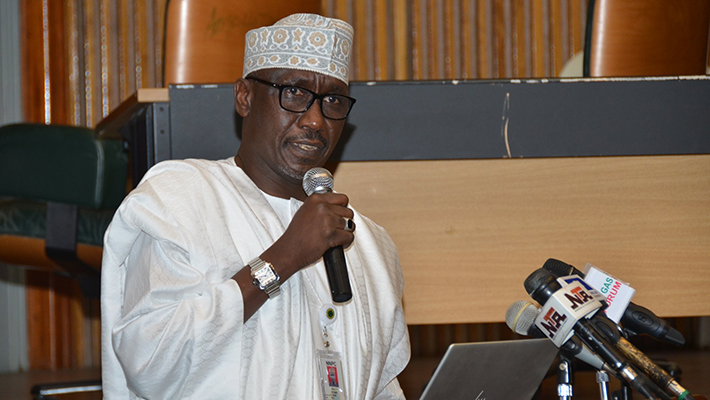

Group Managing Director of NNPC, Mele Kyari
The Nigerian National Petroleum Corporation (NNPC) has said in 18 months gas will be obtained from the Port Harcourt refinery while the plant is still undergoing a total rehabilitation.
It said this would eventually scale up until the contractors leave the site, unlike a new one requiring the whole plant to be completed before it could start functioning.
The Group Managing Director of the corporation, Mele Kyari, said this in Abuja on Monday, while reacting to controversies and claims by some Nigerians on the $1.5bn meant for the rehabilitation project.
He said the $1.5 billion approved for refinery project was for its total rehabilitation and not turnaround maintenance
He said that the refinery would work in optimal capacity at the completion of rehabilitation programme.
According to him, the loan will be repaid as soon as the refinery becomes functional, adding that a refinery can produce a margin of $4-$7 per barrel which will be used to finance the loan.
“We are not doing turnaround maintenance; we are doing rehabilitation of the refinery, and it is very different; it means that we are replacing certain major components.
He disclosed that the actual cost of the project is about $1.34 billion, noting that the additional expenses include taxes and other duties that could come up.
Kyari said, “The real cost is $1.34 billion. Even then you could argue and say why you wouldn’t build a new refinery. We have also seen some curious comparisons that shell sold one of its refineries for $1.2 billion and that it’s even better than our own.
“This is mundane. Even a Google search will reveal that it was built in 1915 and it’s a 107,000 barrels per day refinery. It has been on shut down by the regulators since early last year. Not only that, when you buy a refinery you buy its assets and the liabilities.”
He maintained that many people do not know the financial transactions that go into some negotiations, saying that it is needless to compare a combined refinery of 210, 000 barrels to a much smaller and much older refinery which has many issues with regulators.
“Simple due diligence was not conducted before those comments were made. They have asked why we don’t just build a new one. What does it take to build a refinery of this status today? It’s anywhere between $7 billion to $12 billion to construct a refinery of this nature. This is what we call battery limit construction. That’s the estimate you see in the public space.
“There are things you do outside the battery limits like the tank and other utilities that are never accounted for when the estimates of this nature are done. That’s about 25 per cent of the total cost. So, when you say refineries can be built for $6 billion or even $10 billion, you should also think about the 25 per cent you will add to it,” Kyari said.
He said that another option would have been to scrap the current one and build a new one, but added that the resources are not available while the banking sector is not ready to put in the money because they no longer fund oil projects of that magnitude.
Kyari said that the refineries are national assets that must be used to ensure energy security for the country, maintaining that if a new refinery is started, it cannot become functional in less than four years, which means Nigeria will keep importing in the next four years.
According to him, even for national strategic purposes, that would be a wrong decision, with the last turn-around-maintenance of the Port Harcourt having been done 21 years ago.
The GMD stated that the current huge cost of rehabilitation was because the last turn-around-maintenance was badly carried out.
He said all stakeholders and agencies of the government were involved in the process leading to the award, saying that it wasn’t a TAM that was currently being carried out but total rehabilitation, which means that major components will be replaced, new items will be introduced and an upgrade of the plant.
Kyari argued that the process went through the Bureau of Public Procurement and other such bodies, saying that he was confident that the best decision was taken after the tender process.
He stressed that the process was delayed for the past 10 years because of unwarranted interferences and strategy problems, including going to the original refinery builders, which he said was the wrong thing to do.
Kyari said that the borrowing angle was introduced because typically, lenders will give conditions, one of which is an Operations and Maintenance contract arrangement, meaning that NNPC will not operate the plant, as it will be done in consonance with what he described as the best global practice.
NADDC DG hails Kojo Motors for establishing CNG conversion centre in Owerri Kojo Motors has…
Nnamdi Kanu returns to court, apologises over attacks on judge, others The leader of the Indigenous People…
Binance delists five cryptocurrencies Binance, the world’s largest cryptocurrency exchange, has announced the delisting of…
Akpabio told me I’d make good movements with my waist – Natasha Senator Natasha Akpoti-Uduaghan, who represents…
Supreme Court declares Wike’s ally Anyanwu as PDP National Secretary The Supreme Court on Friday…
Updated: Tinubu reacts as Atiku, Obi, El-Rufai, others form coalition Former Vice President Atiku…